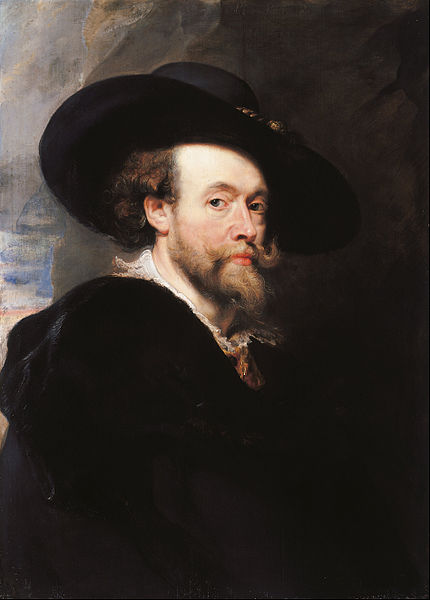
Born: 28 June 1577, Siegen
Died: 30 May 1640 (aged 62)
Period: Baroque
The Life of Peter Paul Rubens
Peter Paul Ruben was a Flemish artist, widely regarded as one of the leading lights of the Baroque art movement. His work is celebrated for its vibrant energy, sensuous richness, and dramatic intensity. Rubens’s mastery of painting, profound understanding of classical and Christian history, and his skillful incorporation of emotional and physical realism make his oeuvre stand out in the history of Western art.
Early Life and Education Rubens was born in Siegen, Nassau-Dillenburg (now Germany), but his family returned to Antwerp (in present-day Belgium) when he was a child, following the death of his father. His upbringing in the Catholic Spanish Netherlands greatly influenced his thematic choices, deeply rooted in Christian iconography and classical mythology. Rubens was a well-educated polyglot, fluent in several languages, which facilitated his interactions with Europe’s elite throughout his career.
Artistic Training and Early Career Rubens’s artistic training included a stint as an apprentice to several prominent painters in Antwerp. By 1600, he traveled to Italy, where he absorbed the influences of Renaissance masters like Leonardo da Vinci, Michelangelo, and Titian. His Italian sojourn was crucial in developing his lush, dynamic style. Upon returning to Antwerp in 1608, Rubens’s reputation grew, and he was appointed as a court painter by the Archduke Albert and Infanta Isabella, the Spanish governors of the Netherlands.
Mature Work and Success Rubens’s studio in Antwerp became a bustling center of activity, producing a vast number of paintings, altarpieces, and tapestries for churches, monarchs, and patrons across Europe. His work was characterized by dynamic compositions, rich color palettes, and voluptuous figures, exemplifying Baroque art’s exuberant spirit. Notable works from this period include “The Descent from the Cross” (1612–1614), “The Assumption of the Virgin Mary” (1626), and the “Marie de’ Medici Cycle” (1622–1625).
Diplomacy and Later Years Rubens was not just a painter but also a respected diplomat, leveraging his art and intellect in the service of peace among the European powers. His diplomatic missions included efforts to broker peace between Spain and England. In his later years, despite suffering from arthritis, Rubens continued to paint prolifically, exploring more personal and intimate themes alongside his grand commissions.
Death and Legacy Rubens died in 1640 in Antwerp and was buried in the Saint James’ Church. His legacy is profound, with his influence permeating not just the Baroque period but also the development of later artistic movements. Rubens’s ability to blend the physical with the spiritual, the sensual with the divine, set a new standard for emotional expressiveness and technical mastery in art. His works remain pivotal in the study of Baroque art, celebrated for their vitality, dramatic force, and intricate iconography.
Peter Paul Rubens’ Notable Works
Peter Paul Rubens, a towering figure of the Baroque period, left an indelible mark on the art world through his dynamic compositions, vibrant colors, and emotional intensity. His oeuvre spans religious and mythological scenes, portraits, and landscapes, showcasing his versatility and creativity. Here are ten of Rubens’s most famous and influential works:
- “The Descent from the Cross” (1612–1614) – Located in Antwerp’s Cathedral of Our Lady, this masterpiece is celebrated for its dramatic portrayal of Christ’s removal from the cross, showcasing Rubens’s mastery of human emotion and physicality.
- “The Assumption of the Virgin Mary” (1626) – Also in the Cathedral of Our Lady, Antwerp, this altarpiece is noted for its dynamic composition and vibrant depiction of Mary’s ascent to heaven.
- “The Elevation of the Cross” (1610-1611) – This triptych, another highlight from Antwerp’s Cathedral of Our Lady, demonstrates Rubens’s skill in conveying movement and muscular figures, emphasizing the drama of Christ’s crucifixion.
- “The Massacre of the Innocents” (c. 1611–1612) – Now housed in the Art Gallery of Ontario, Toronto, this work reflects the darker side of human history, depicting the biblical story with intense emotion and brutality.
- “The Garden of Love” (c. 1633) – Exhibited in the Prado Museum, Madrid, this painting is renowned for its romantic and sensual depiction of aristocratic couples in a lush garden, embodying the pleasures of love.
- “The Marie de’ Medici Cycle” (1622–1625) – A series of 24 paintings commissioned by Marie de’ Medici for the Luxembourg Palace in Paris, now in the Louvre, celebrating her life and reign as Queen of France through allegorical and historical scenes.
- “The Three Graces” (1635) – Also in the Prado Museum, this mythological painting is admired for its depiction of the three daughters of Zeus, showcasing Rubens’s talent for rendering the beauty of the female form.
- “Diana and Her Nymphs Hunting” (c. 1615) – Highlighting Rubens’s ability to depict dynamic scenes of action and the idealized natural world, this work exemplifies his interest in classical mythology.
- “Samson and Delilah” (c. 1609-1610) – Held in the National Gallery, London, this painting captures the moment of Samson’s betrayal by Delilah with dramatic intensity and rich coloration.
- “Prometheus Bound” (c. 1611-1618) – A collaboration with Frans Snyders for the eagle, this painting in the Philadelphia Museum of Art illustrates the punishment of Prometheus for giving fire to humanity, highlighting Rubens’s skill in depicting human suffering and resilience.
Rubens’s artistry is characterized by his unique ability to blend the realistic with the ideal, the earthly with the divine, creating works that continue to captivate and inspire. His influence extends beyond his lifetime, shaping the direction of Western art for centuries.